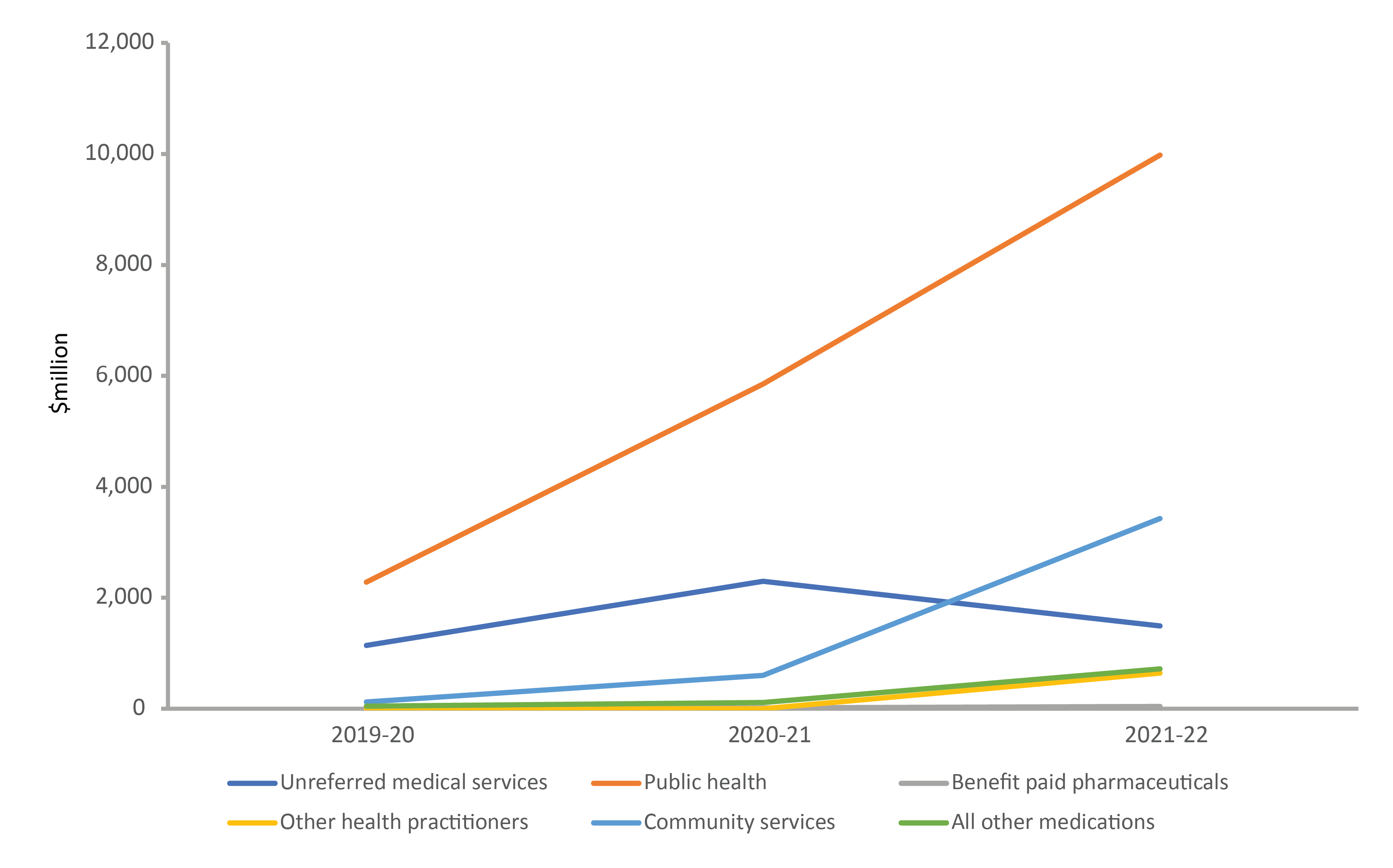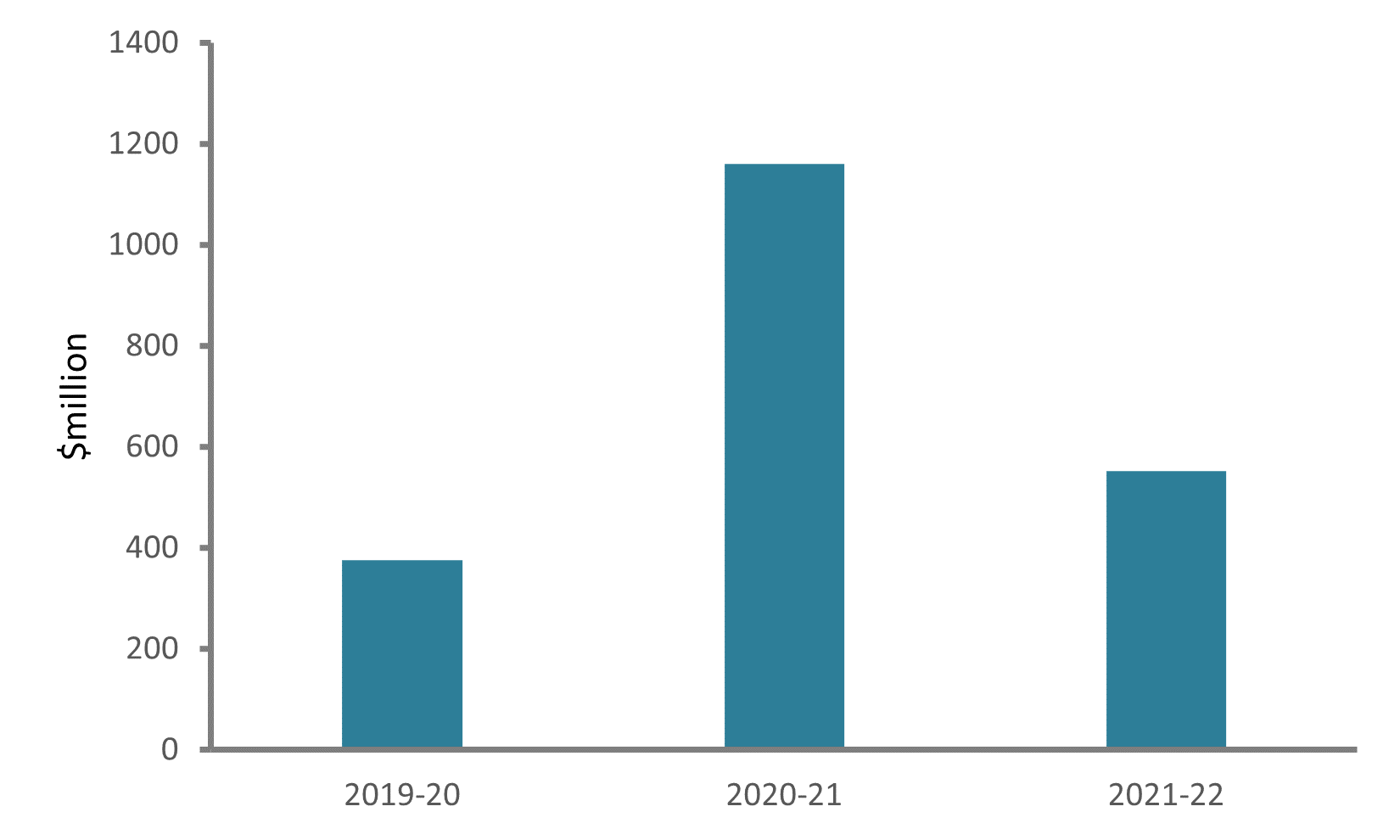Spending by area
In this section, the total health spending of $47.9 billion on the response to COVID-19 for 2019-20 to 2021-22 is allocated across the broad areas of spending as per the Australian National Health Account categories, which are: primary health care, hospitals, referred medical services and others.
Primary health care
During the pandemic from 2019–20 to 2021–22, $28 billion (49%) of total government COVID–19 related expenditure was spent on primary health care, this included:
- $18.1 billion (65%) for public health activities including vaccine response ($6.1 billion), personal protective equipment ($3 billion), communication programs ($1.8 billion), RAT subsidies ($0.8 billion).
- $5 billion (18%) for unreferred medical services mainly telehealth ($4.3 billion) and vaccine administration ($0.1 billion).
Estimated spending by individuals on primary health care from 2019–20 to 2021–22 was around $878 million spent almost entirely on over–the–counter COVID–19 related products ($877 million). The remaining $1.4 million, was for PBS pharmaceuticals approved by the TGA for the treatment of COVID–19 ($1.3 million) and unreferred medical services ($0.1 million) such as vaccine suitability assessments and support for patients isolating with COVID–19. These services were all primarily bulk billed with little to no out–of–pocket costs incurred by patients.
Figure 9: Areas of spending for COVID–19, Primary health care, 2019–20 to 2021–22

Source: Department of Health and Aged Care, National Health Funding Body, IQVIA.
Hospitals
The total government spending on the response to COVID–19 for hospitals was $11.9 billion (25%) over the three financial years of the pandemic (2019–20 to 2021–22). Of this, $10.5 billion was for public hospitals and $1.4 billion was for private hospitals that mainly consisted of financial viability payments. Table 3 shows the total hospital COVID-19 related spending for each year compared to the number of confirmed COVID–19 cases, hospital separations, intensive care unit stays (ICU), continuous ventilatory support (CVS) and deaths, with a COVID–19 related diagnosis. See Admitted Patient Activity.
There was also a substantial number of presentations to specialised COVID–19 outpatient clinics, primarily for COVID–19 PCR tests, that are not captured as a measure of activity in Table 3. See Health system spending on disease and injury in Australia 2020-21 report.
| 2019–20 | 2020–21 | 2021–22 | Total |
|---|---|---|---|---|
Total Government Spending ($billion) | 1.9 | 3.9 | 6.1 | 11.9 |
Confirmed COVID-19 cases | 8,593 | 22,418 | 7,933,990 | 7,965,001 |
Hospital Separations* | 2,478 | 4,718 | 263,425 | 270,771 |
ICU* | 225 | 329 | 7,774 | 8,328 |
CVS* | 138 | 180 | 3,338 | 3,656 |
Deaths* | 105 | 487 | 5,265 | 5,857 |
* with a COVID-19 related diagnosis
Source: National Notifiable Diseases Surveillance System, Australian Institute of Health and Welfare, National Health Funding Body, Dept of Health and Aged Care
Referred medical services
After primary health care, and hospitals, the highest COVID–19 related spending was for referred medical services at $2.8 billion. Referred medical services include non–hospital medical services that are not classified as primary health care. Some of the services during the pandemic include microbiology testing and pathology ($2.1 billion), telehealth extension support ($0.2 billion) and early mental health interventions ($0.04 million).
Aged care
Over a period of 2019–20 to 2021–22, a total of $2 billion was spent on aged care (Figure 10). Aged spending broadly involved aged care workforce ($0.5 billion), COVID–19 preparedness ($0.2 billion), Rapid Antigen testing (0.06 million) among other areas. The Australian National Health Account categorises spending in the aged care sector as welfare spending and as such it is excluded from estimates of health care spending. For this report however, the exception is being made to include COVID–19 related health spending that occurred in the aged care setting.
Figure 10: Health–related Aged Care spending for COVID–19, 2019–20 to 2021–22

Chart: AIHW
Source: National Health Funding Body, Dept of Health and Aged Care
Other Areas
During 2019–20 to 2021–22, other areas of spending besides primary health care, hospitals and aged care are totalled to an estimated $2.2 billion of which:
- $1.4 billion on capital expenditure
- $0.5 billion on patient transport costs
- $0.2 billion on health administration


